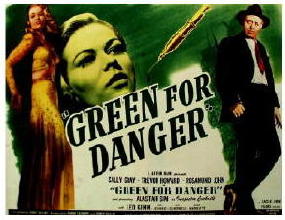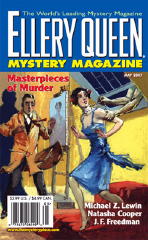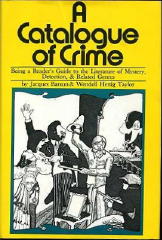Tue 20 Mar 2007
MIKE NEVINS on Christianna Brand, EQMM, and Jacques Barzun
Posted by Steve under Authors , Columns , Magazines , Mystery movies1 Comment
by Francis M. Nevins
The centenaries have come thick and fast lately: Woolrich in 2003, Fred Dannay and Manny Lee in ‘05, John Dickson Carr last year. Now we celebrate one of the great masters of English detective fiction, Christianna Brand. She was born Mary Christianna Milne in Malaya – on December 17th of, as if you hadn’t guessed, 1907 – began writing whodunits a couple of years after the start of World War II, and is best known as the author of Green for Danger (1944), a classic of fair-play detection set in a military hospital in Kent during the Blitz.
I got to meet her when she was around 70 and quickly discovered that she was as perfect in the role of the dotty English lady as was Basil Rathbone playing Holmes. Who can ever forget the MWA dinner where she was asked to present one of the Edgar awards? “The nominees are: Emily Smith, James Quackenbush….Hahaha, Quackenbush, what a funny name!” The audience, except perhaps for poor Quackenbush, was left rolling in the aisles.
On my first visit to England, to serve as an expert witness at a trial in the Old Bailey during the summer of 1979, Christianna and her husband Roland Lewis, one of England’s top ear-nose-and-throat surgeons, took me to dinner at Simpson’s in the Strand, the famous old eatery where one tips the server who carves your roast beef tableside. A few years later I edited Buffet for Unwelcome Guests (1983), the first collection of her short stories published in the U.S. On my next visit to England after the book came out I could hardly lift my suitcases, which were packed to bursting with copies for her. She died on March 11, 1988, and everyone who knew her still misses her.

The 1946 movie version of Green for Danger, starring Alastair Sim as the insufferable Inspector Cockrill and featuring superb English actors like Trevor Howard and Leo Genn, has long been considered one of the finest pure detective films ever made, but it’s been very hard to access over here until just a month or so ago when, in a miracle of perfect timing, it was released on DVD. If you love the classic whodunit but have never seen the film nor read the book, you have a double treat in store.
The tale of fair-play detection has become a dying art, but each of two recent issues of Ellery Queen Mystery Magazine has featured at least one specimen worthy of the Golden Age. Jon L. Breen’s “The Missing Elevator Puzzle” (February 2007) is quite simply the finest short whodunit with an academic setting that I can recall reading, with a puzzle that might have fazed Ellery himself: Why was a visitor to the campus, just before being murdered, searching for the elevator in a building that had none?

“The Book Case” (May 2007) by Dale Andrews and Kurt Sercu not only has two authors like the Queen books themselves but returns to center stage their most famous detective, physically frail but mentally spry at age 100, as he tackles a murder with a dying message composed of copies of his own novels. Readers who aren’t well up on those novels are likely to get lost in this tale, but if you’re at home in the canon you’ll have a high old time trying to beat the centenarian sleuth to the solution.
In most centenary celebrations the subject is dead, but there’s one coming up in just a few months where the honoree is still with us – and, so I’m told, doing well for a 99-year-old. He claims to have written a number of short whodunits published under a pseudonym in his student years but his real significance for us lies in his extensive writing about the genre over several decades and in his connection with the supreme master of pure suspense fiction.
I am referring of course to Jacques Barzun, distinguished professor at Columbia University, co-author of the massive Catalogue of Crime, and, in the early 1920s, Columbia classmate of Cornell Woolrich, who quit college in third year when his first novel sold.

My first contact with Dr. Barzun was back in the late Sixties when I arranged to include one of his essays in my anthology The Mystery Writer’s Art (1970). In April 1970, while I was working on Nightwebs (1971), my first collection of Woolrich stories, he invited me to his Columbia office and we spent most of an afternoon talking about what the university was like almost half a century earlier when he and Woolrich were undergraduates together and sat next to each other for several courses.
We corresponded off and on for several years. After translating from the French (a language I had never studied) an essay about Georges Simenon’s pre-Maigret crime novels, I presumed on my acquaintanceship with Barzun and asked him to look over my draft before I sent it in to The Armchair Detective. He made many small corrections, one of which I still vividly remember: I had rendered a line from an early Simenon as “Marc’s bottle was empty” which he changed to “The bottle of marc was empty,” pointing out to me that marc is a cheap French brandy. But on the whole he was hugely pleased with my translation, saying that he was “truly amazed” that I had done it without ever having taken a French course and that it was “certainly better than much advanced student work in a Romance Language Department.”
In the early Eighties I became involved with Nacht Ohne Morgen (Night Without Morning), a documentary on Woolrich for German TV, and arranged for the director, Christian Bauer, to interview Barzun. They talked for almost an hour but only about a minute of footage found its way into the finished film. I obtained an audiotape of the entire interview and quoted from it extensively in my own Woolrich book First You Dream, Then You Die (1988). If Jacques Barzun had not been still alive and well and blessed with a vivid memory, we would know so much less about a key period in Woolrich’s life. For that gift to the genre and for countless others, merci beaucoup. May his hundredth birthday be a joyous one and not his last.
April 4th, 2007 at 9:16 pm
Thanks to Christian Bauer and Mike Nevins, the interview of Barzun by Christian Bauer can now be heard on:
http://barzuncentennial.murphywong.net/
Click on Christian Bauer, then Part 1 and Part 2.